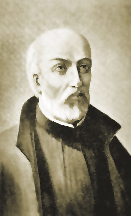
The eight Jesuits--Jean de Brébeuf,Noël Chabanel, Antoine Daniel, Charles Garnier, René Goupil, Isaac Jogues,Jean de Lalande and Gabriel Lalemant--are some of the most heroic and noble men in the church’s calendar of saints. They worked in the wilderness, among people with whom they had little in common other than their common humanity, far from their homelands, sometimes together, sometimes apart, always bound to the Lord, in “New France,” in the 17th century.
His life, like the lives of all the North American Martyrs, has much to teach us about working and living among those who are different from us, the inevitability of difficulties even for the most devout of souls and the necessity of faith at all times.
When he returned to New France in 1635, he was cheerfully welcomed by his Huron friends. Immediately he and Antoine Daniel, another Jesuit, began their work in earnest. (They were one of several Jesuits working in the region at the time.) Near a town called Ihonotiria, near current-day Georgian Bay in Canada, Fathers Brébeuf and Daniel began teaching the people about Christianity. They were later joined by two other French Jesuits, Charles Garnier and Isaac Jogues.
With the arrival of their new companions, though, a smallpox epidemic broke out among the Jesuits, which spread to the Hurons, who had no immunity whatsoever from the illness. The missionaries cared for the sick and baptized thousands of Hurons. But because they had baptized those who were dying, the Hurons concluded that baptism brought death, and so many of the Hurons began to turn against the "Blackrobes." Brébeuf then moved to Sainte-Marie, a center for the Jesuits in the area.
Then a new danger arose. Rumors (false ones) circulated that Jean was in league with a sworn enemy of the Hurons, the Seneca clan of the Iroquois. So he prudently moved to another site, Saint Louis. On March 16, the Iroquois attacked the village and took the Hurons, who were mainly Christians, along with Jean and another Jesuit, Gabriel Lalement, prisoner. He knew that the possibility of martyrdom was imminent.
Jean de Brébeuf's torture was among the cruelest any Jesuit has had to endure. (You might want to avoid this next paragraph if you're squeamish.)
The Iroquois heated hatchets until they were glowing red and, tying them together, strung them across his shoulders, searing his flesh. They wrapped his torso with bark and set it afire. They cut off his nose, lips and forced a hot iron down his throat, and poured boiling water over his head in a gruesome imitation of baptism. They scalped him, and cut off his flesh while he was alive. Finally someone buried a hatchet in his jaw.
After 14 years as a missionary, Jean de Brébeuf died on March 16, 1639. He was 56. At his death his heart was eaten as a way for the Iroquois, who were stunned by his courage, to share in his bravery. Eight other Jesuits were martyred around this same time, and are now referred to as the North American Martyrs.
May they pray for us and be our examples of patience, fortitude and faith.
Excerpt from James Martin, SJ
